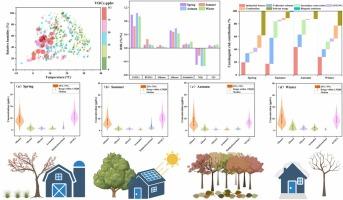Insights into the source characterization, risk assessment and ozone formation sensitivity of ambient VOCs at an urban site in the Fenwei Plain, China
IF 12.2
1区 环境科学与生态学
Q1 ENGINEERING, ENVIRONMENTAL
引用次数: 0
Abstract
The ground-level O3 concentration has shown a deteriorating trend in the Fenwei Plain of China, which poses a greater challenge for the formulation of control strategies for O3 precursor (VOCs). To accurately control VOCs sources and effectively reduce O3 concentration from the aspect of season, online monitoring of 114 VOCs was conducted in Yuncheng Middle School Station from January 1, 2021 to December 31, 2021. The VOCs concentration showed a seasonal variation with the highest in winter and the lowest in summer. During the four seasons, alkanes (34.5-41.7%) and OVOCs (36.6-46.9%) were the most abundant species. The emission ratios of specific VOCs species indicated that vehicular exhaust, industrial source, and combustion were the major VOCs sources. The Positive Matrix Factorization (PMF) model identified that industrial source and secondary conversion were the main contributors in summer, while combustion and LPG/NG with the higher contribution in winter. The 2021-based VOCs emission inventory showed that the total VOCs emissions in the central urban area of Yuncheng was 8128.8 t, in which industrial process was the largest contributor. Alkanes, aromatics, and OVOCs accounted for 31.0%, 25.8%, and 25.7% of the annual VOCs emission, respectively. In addition, the calculated relative incremental reactivity (RIR) values of O3 precursors demonstrated alkenes and aromatics were the most sensitive groups to O3 formation during the four seasons. The ambient VOCs posed the non-carcinogenic risk in all seasons, which can be attributed to acrolein and three main sources (industrial source, secondary conversion, and combustion). However, ambient VOCs were exposed to definite carcinogenic risks due to the appearance of 1,2-dichloroethane, 1,2-dichloropropane, and benzene, and the main risks arose from industrial source, vehicular exhaust, and solvent usage. These findings emphasize the necessity of undertaking scientific and systematic measures for priority species and control sources of VOCs emission.

求助全文
约1分钟内获得全文
求助全文
来源期刊

Journal of Hazardous Materials
工程技术-工程:环境
CiteScore
25.40
自引率
5.90%
发文量
3059
审稿时长
58 days
期刊介绍:
The Journal of Hazardous Materials serves as a global platform for promoting cutting-edge research in the field of Environmental Science and Engineering. Our publication features a wide range of articles, including full-length research papers, review articles, and perspectives, with the aim of enhancing our understanding of the dangers and risks associated with various materials concerning public health and the environment. It is important to note that the term "environmental contaminants" refers specifically to substances that pose hazardous effects through contamination, while excluding those that do not have such impacts on the environment or human health. Moreover, we emphasize the distinction between wastes and hazardous materials in order to provide further clarity on the scope of the journal. We have a keen interest in exploring specific compounds and microbial agents that have adverse effects on the environment.
 求助内容:
求助内容: 应助结果提醒方式:
应助结果提醒方式:


